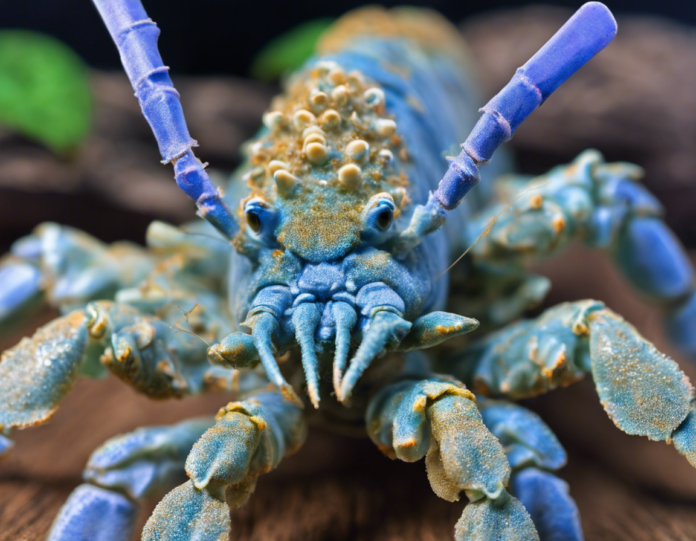The world of crustaceans is a fascinating one, with a myriad of species exhibiting different colors, sizes, and characteristics. One of the most intriguing and beautiful creatures in this realm is the blue lobster (Homarus americanus), which stands out due to its striking cobalt blue hue. Often hailed as a marvel of nature, the blue lobster is a rare find, captivating both scientists and enthusiasts alike.
Understanding the Blue Lobster
The blue coloration of these lobsters is a result of a genetic anomaly that causes an overproduction of a particular protein. This protein, known as crustacyanin, combines with a red carotenoid molecule to form a unique blue complex known as astaxanthin. Astaxanthin is also responsible for the pink coloration seen in cooked lobster.
One of the crucial things to note about blue lobsters is that they are not a separate species. Instead, they are a color variation of the common American lobster. The odds of finding a blue lobster are estimated to be around 1 in 2 million, making them a rare and prized discovery for fishermen and marine enthusiasts.
Habitat and Behavior
Blue lobsters inhabit the same environments as their more conventionally colored counterparts. They are primarily found in the western Atlantic Ocean, ranging from North Carolina up to the Canadian Maritimes. Blue lobsters exhibit similar behavior and feeding habits to other lobsters, primarily scavenging on small fish, mollusks, and other marine organisms.
In terms of size, blue lobsters are comparable to regular American lobsters, with adults reaching lengths of around 25-50 centimeters and weighing up to 4.5 kg. They have a hard exoskeleton for protection, which they periodically shed as they grow—a process known as molting.
Significance and Conservation
The discovery of a blue lobster is often met with excitement and wonder, both in scientific circles and among the general public. These unique creatures serve as a reminder of the incredible diversity found in nature and the unpredictable ways in which genetic traits can manifest.
In recent years, there has been a growing interest in the conservation of blue lobsters and other rare color variants. Conservation efforts aim to protect not only these distinct individuals but also the overall lobster populations, which face threats from factors such as overfishing, pollution, and habitat destruction.
Variations in Color
While the blue lobster is the most famous color variant, it is not the only one that exists in the lobster world. Lobsters can exhibit a range of colors, including yellow, orange, calico, and white. Each of these variations is the result of different genetic mutations that affect the production of pigments in the lobster’s shell.
White lobsters, for example, lack the usual pigments present in lobster shells, giving them a ghostly appearance. Yellow and orange lobsters, on the other hand, have higher levels of particular pigments that result in their vibrant hues. Calico lobsters display a mottled pattern of colors, resembling the markings of a calico cat.
Famous Blue Lobsters
Over the years, several blue lobsters have gained fame for their unique coloration and captured the public’s imagination. One notable example is the Cotton Candy Lobster, a blue lobster with patches of pink and white, resembling the popular carnival treat. This striking specimen was discovered off the coast of Maine and eventually found a home at the Maine State Aquarium.
Another famous blue lobster was found in Canada and aptly named Blueberry. This lobster stood out not only for its vivid blue color but also for its unusually large size. Blueberry garnered attention from researchers and the media, shedding light on the extraordinary diversity of the marine world.
Captivating Oddities
Blue lobsters are not the only unusual crustaceans to be found in the ocean. There is a wide array of oddball lobsters that showcase unique traits and colors. One such example is the two-toned lobster, which displays a stark contrast in color between its two halves—a result of a genetic split down the middle. These lobsters are exceptionally rare and highly sought after for research purposes.
In addition to color variations, lobsters can also exhibit extra claws, split claws, or even extra legs due to genetic anomalies. These oddities, while fascinating to observe, can sometimes pose challenges for the lobster in terms of survival and reproduction in the wild.
The Mystique of the Blue Lobster
The allure of the blue lobster lies not only in its rare and captivating coloration but also in the mysteries it holds regarding genetics and evolution. Scientists continue to study these unique creatures to unravel the secrets behind their striking appearance and understand how genetic mutations contribute to biodiversity.
As we delve deeper into the world of blue lobsters and other extraordinary crustaceans, we gain a greater appreciation for the marvels of the natural world and the endless possibilities for discovery that lie beneath the waves.
Frequently Asked Questions (FAQs)
-
Are blue lobsters safe to eat?
Blue lobsters are safe to eat and are considered a delicacy in many regions. The blue coloration is only present in the shell and does not affect the taste or quality of the lobster meat. -
How rare are blue lobsters?
Blue lobsters are incredibly rare, with odds of finding one estimated to be around 1 in 2 million. Their scarcity adds to their allure and value. -
Do blue lobsters change color when cooked?
Yes, like other lobsters, blue lobsters turn red when cooked due to the heat-induced changes in the proteins and pigments in their shells. -
Can blue lobsters be kept as pets?
While possible, keeping a blue lobster as a pet requires a specialized aquarium setup and thorough knowledge of their care requirements. They are not commonly kept as pets due to their specific needs. -
Do blue lobsters have any predators in the wild?
Blue lobsters, like other lobsters, have various predators in the wild, including large fish, sharks, seals, and even other lobsters. Their hard exoskeleton provides some protection against predation. -
What is the lifespan of a blue lobster?
Blue lobsters have a similar lifespan to other American lobsters, with some individuals living up to 50 years in the wild. Factors such as predation, disease, and environmental conditions can impact their longevity. -
Can blue lobsters change color over time?
While the blue coloration of lobsters is primarily genetic, environmental factors such as diet and habitat conditions can influence the intensity of their color. However, the fundamental blue hue remains consistent throughout their lives. -
Are blue lobsters nocturnal?
Blue lobsters, like most lobsters, are primarily nocturnal and are more active during the night when they forage for food and engage in mating behaviors. -
Do blue lobsters have any special adaptations for survival?
Blue lobsters possess the same adaptations as other lobsters, such as their ability to regenerate lost limbs, their keen sense of smell, and their proficient scavenging skills. These traits help them survive in their marine habitats. -
Can blue lobsters interbreed with other lobster color variants?
Yes, blue lobsters have the potential to interbreed with other color variants of lobsters, resulting in offspring with a mix of genetic traits. This interbreeding contributes to the genetic diversity within lobster populations.






